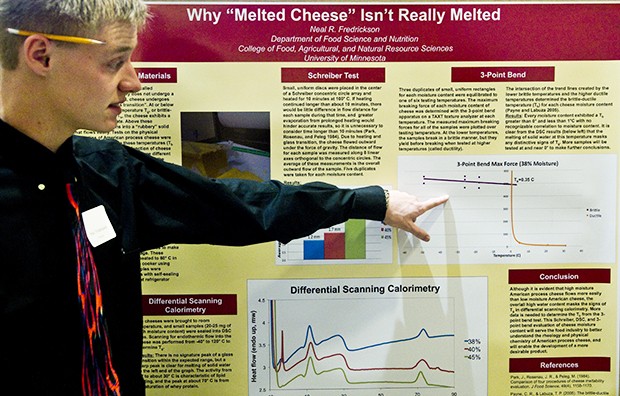Neuroscience senior Kathleen Kane learned how to be a mouse brain surgeon through her research this year, and along with about 250 other undergraduates, she presented the results of that work Wednesday at the University of Minnesota. While the majority of the projects involved life or physical science, some students presented social science research and creative work. Student participation rose last year, when the Office of Undergraduate Research took over the symposium, which had previously been hosted by the College of Biological Sciences. Participation was about the same this year. StudentsâÄô work was the result of the Undergraduate Research Opportunities Program (UROP) grants awarded by the University, directed research theyâÄôve done for class credit and work theyâÄôve done for faculty members. The poster session is the studentsâÄô way of sharing the results of their research with an audience, UROP coordinator Vicky Munro said. Students need to be able to communicate their research, she said, and this is a chance for them to practice. âÄúIf you did research and never presented it, whatâÄôs the point?âÄù Munro said. Along with family, friends and mentors, fellow students âÄî some receiving extra credit for it âÄî attended the presentations. Campus librarians also perused the display, looking for about 40 posters to put up in University libraries. University relations personnel were also seeking material for an upcoming poster week at the state Capitol, Munro said. Undergraduate research is becoming more popular. Physics professor Marvin Marshak , who directs undergraduate research at the University, said he saw a 20 percent jump in UROP applications this spring. Graduating CBS honors students are required to present their research, Sarah Corrigan , assistant director in the CBS and University honors program, said. But sheâÄôd like to expand the focus of the symposium to include more interactive displays, like poetry and dance. She wants to see people incorporating their interest in artistic areas into research questions. Bridget Noltimier âÄôs senior project on West Side Story choreography blossomed into a UROP, and sheâÄôs been working more than the grant pays her for, but is happy to be working on âÄúa piece of history,âÄù she said. The dance senior is translating the original choreography manual for the West Side Story musical into shorthand for a local high school stage and coordinating it with the musical score âÄî a rare opportunity. To inform her work, sheâÄôs been researching the life and influence of Jerome Robbins, who conceived, directed and choreographed the musical. Every dance movement needs to have a meaning, she said, and she needs to know what those are to effectively help direct and choreograph it. SheâÄôll see her work in motion when students from a St. Louis Park high school perform it in early May. The school purchased the rights to perform the original work and commissioned NoltimierâÄôs mentor, who has worked with Robbins, to help them. âÄúIt doesnâÄôt happen very often to get the rights and work with someone who knows it in such detail,âÄù she said. âÄúItâÄôs like a really difficult musical puzzle.âÄù The itch sensation was KaneâÄôs research puzzle. She explored how an itch is communicated from the skin to the brain, focusing on a certain spinal cord pathway in mice. To do it, she had to anesthetize the rodents, inject a fluorescent tracker into their brains and then inject histamine, a chemical that causes itching. To find out which cells are involved in transmitting the itching sensation, she had to dissect and slice up the mouse brain and spinal cord, then stain it so she could see certain cells. She had to experiment on 18 mice before she found a method that worked well, and though it was frustrating, she said thatâÄôs the way science works.

Image by Matt Mead
University food science first year Neal Fredrickson speaks about his cheese research at an undergraduate symposium held at the Coffman Memorial Union’s Great Hall on Wednesday.
Symposium highlights student work
About 250 undergraduates presented their research and creative work Wednesday.
Published April 8, 2009
0

